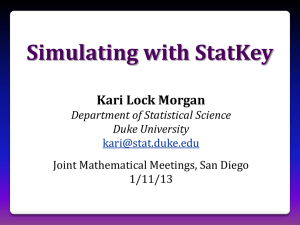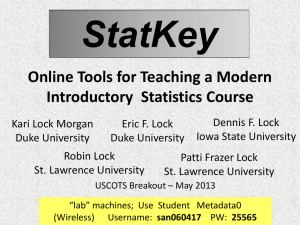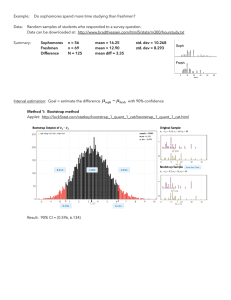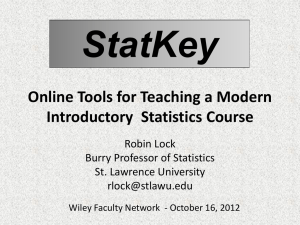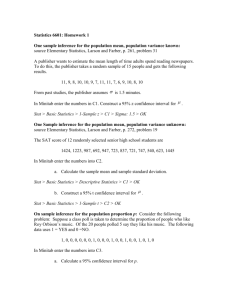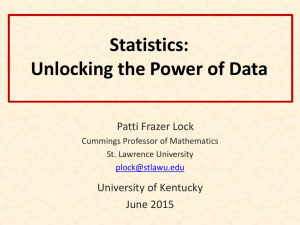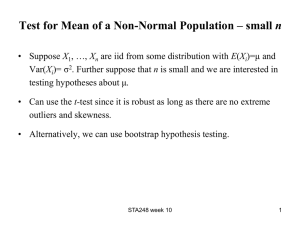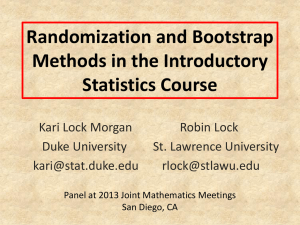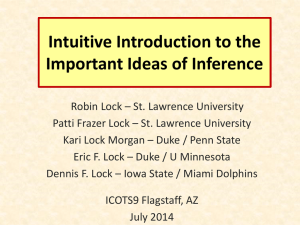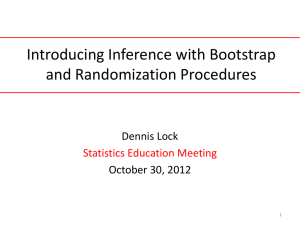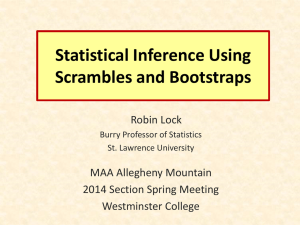- Unlocking the Power of Data
advertisement
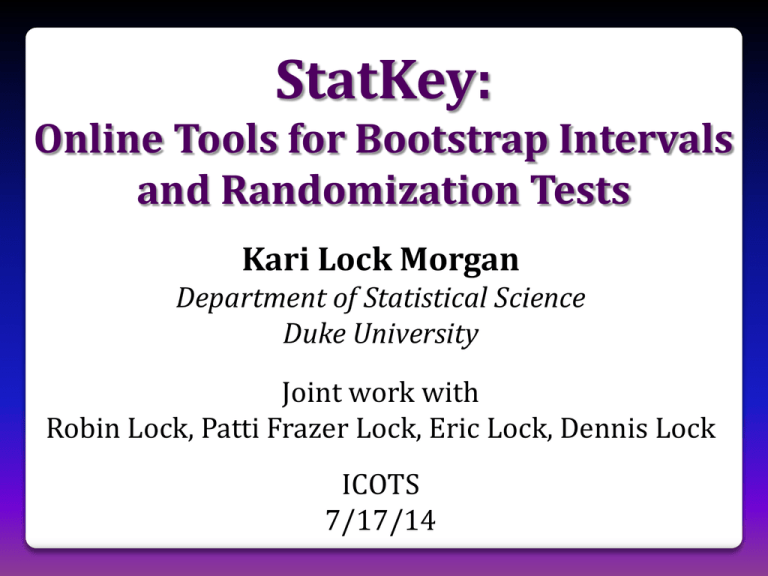
StatKey: Online Tools for Bootstrap Intervals and Randomization Tests Kari Lock Morgan Department of Statistical Science Duke University Joint work with Robin Lock, Patti Frazer Lock, Eric Lock, Dennis Lock ICOTS 7/17/14 StatKey A set of web-based, interactive, dynamic statistics tools designed for teaching simulation-based methods at an introductory level. Freely available at www.lock5stat.com/statkey No login required Runs in (almost) any browser (incl. smartphones) Google Chrome App available (no internet needed) Standalone or supplement to existing technology StatKey • Developed by the Lock5 team Robin & Patti St. Lawrence Dennis Miami Dolphins Kari Duke / Penn State Eric U Minnesota Wiley (2013) • Developed for our book, Statistics: Unlocking the Power of Data (although can be used with any book) • Programmed by Rich Sharp (Stanford), Ed Harcourt and Kevin Angstadt (St. Lawrence) StatKey Goals • Free • Convenient • Very easy-to-use • Helps promote understanding • For those who want to use simulation methods, technology should not be a limiting factor! Bootstrap Confidence Interval • What is the average mercury level of fish (large mouth bass) in Florida lakes? • Sample of size n = 53, with 𝑥 = 0.527 ppm. • Give a confidence interval for true average. • Key Question: How much can statistics vary from sample to sample? • www.lock5stat.com/statkey Lange, T., Royals, H. and Connor, L. (2004). Mercury accumulation in largemouth bass (Micropterus salmoides) in a Florida Lake. Archives of Environmental Contamination and Toxicology, 27(4), 466-471. Bootstrap Confidence Interval Original Sample Distribution of Simulated Statistics One Simulated Sample Bootstrap Confidence Interval Distribution of Bootstrap Statistics SE = 0.047 𝑠 0.341 = = 0.047 𝑛 53 0.527 2 0.047 (0.433, 0.621) Middle 95% of bootstrap statistics CI for Proportion • Have you used simulation-based methods (bootstrap confidence intervals or randomization tests) in your teaching? Randomization Test • 75 hotel maids were randomized to treatment and control groups, where the “treatment” was being informed that the work they do satisfies recommendations for an active lifestyle • Weight change 𝑥𝑇 − 𝑥𝐶 = −1.59 lbs • Does this information help maids lose weight? • Key Question: What kinds of sample differences would we observe, just by random chance, if there were no actual difference? Crum, A. and Langer, E., (2007). Mind-Set Matters: Exercise and the Placebo Effect. Psychological Science, 18, 165-171. Randomization Test Distribution of Statistic Assuming Null is True Proportion as extreme as observed statistic observed statistic p-value NFL Teams -0.5 0.0 0.5 • Do NFL teams with more malevolent uniforms get more penalty yards? -1.5 -1.0 z-score for Penalty Yards 1.0 Malevolent Uniforms r = 0.43 3.0 3.5 4.0 4.5 5.0 Malevolence Rating of Uniform StatKey Pedagogical Features • Ability to simulate one to many samples • Helps students distinguish and keep straight the original data, a single simulated data set, and the distribution of simulated statistics • Students have to interact with the bootstrap/randomization distribution – they have to know what to do with it • Consistent interface for bootstrap intervals, randomization tests, theoretical distributions Theoretical Distributions •Maid weight loss example: • t-distribution • df = 33 𝑡= 𝑥1 − 𝑥2 𝑠12 𝑛1 + 𝑠22 𝑛2 = −0.2 − (−1.79) 2.322 2.882 + 34 41 = 2.65 Chi-Square Test Randomization Distribution p-value = 0.105 2 = 6.168 Chi-Square Distribution (3 df) p-value = 0.104 2 = 6.168 Help • Help page, including instructional videos Suggestions? Comments? Questions? • You can email me at klm47@psu.edu or the whole Lock5 team at lock5stat@gmail.com
